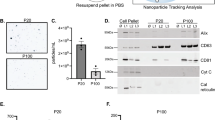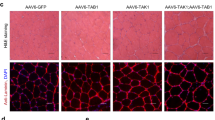Abstract
To determine the role of the p75 neurotrophin receptor (p75NTR) in sympathetic neuron development, we crossed transgenic mice with mutations in p75NTR, nerve growth factor (NGF) and neurotrophin-3 (NT-3). Neuron number is normal in sympathetic ganglia of adult p75NTR–/– mice. Mice heterozygous for a NGF deletion (NGF+/–) have 50% fewer sympathetic neurons. In the absence of p75NTR (p75NTR–/– NGF+/–), however, neuron number is restored to wild-type levels. When NT-3 levels are reduced (p75NTR–/– NGF+/– NT3+/–), neuron number decreases compared to p75NTR–/– NGF+/– NT3+/+. Thus, without p75NTR, NT3 substitutes for NGF, suggesting that p75 alters the neurotrophin specificity of TrkA in vivo.
This is a preview of subscription content, access via your institution
Access options
Subscribe to this journal
Receive 12 print issues and online access
$209.00 per year
only $17.42 per issue
Buy this article
- Purchase on Springer Link
- Instant access to full article PDF
Prices may be subject to local taxes which are calculated during checkout





Similar content being viewed by others
References
Bothwell, M. Functional interactions of neurotrophins and neurotrophin receptors. Annu. Rev. Neurosci. 18, 223–253 (1995).
Kaplan, D. R. & Miller, F. D. Signal transduction by the neurotrophin receptors. Curr. Opin. Cell Biol. 9, 213 –221 (1997).
Huber, L. J. & Chao, M. V. A potential interaction of p75 and trkA NGF receptors revealed by affinity crosslinking and immunoprecipitation. J. Neurosci. Res. 40, 557– 563 (1995).
Bibel, M., Hoppe, E. & Barde, Y. A. Biochemical and functional interactions between the neurotrophin receptors trk and p75(NTR). EMBO J. 18 , 616–622 (1999).
Dechant, G. & Barde, Y. A. Signaling through the neurotrophin receptor p75NTR. Curr. Opin. Neurobiol. 7, 413–418 (1997).
Frade, J. M. & Barde, Y. A. Nerve growth factor: two receptors, multiple functions. Bioessays 20, 137– 145 (1998).
Barker, P. A. p75NTR: A study in contrasts. Cell Death Differ. 5, 346–356 (1998).
Smith, C. A., Farrah, T. & Goodwin, R. G. The TNF receptor superfamily of cellular and viral proteins: activation, costimulation, and death. Cell 76, 959–962 (1994).
Dobrowsky, R. T., Werner, M. H., Castellino, A. M., Chao, M. V. & Hannun, Y. A. Activation of the sphingomyelin cycle through the low-affinity neurotrophin receptor. Science 265, 1596–1599 (1994).
Dobrowsky, R. T., Jenkins, G. M. & Hannun, Y. A. Neurotrophins induce sphingomyelin hydrolysis. Modulation by co-expression of p75NTR with Trk receptors. J. Biol. Chem. 270, 22135–22142 (1995).
Casaccia-Bonnefil, P., Carter, B. D., Dobrowsky, R. T. & Chao, M. V. Death of oligodendrocytes mediated by the interaction of nerve growth factor with its receptor p75. Nature 383, 716– 719 (1996).
Bamji, S. X. et al. The p75 neurotrophin receptor mediates neuronal apoptosis and is essential for naturally occurring sympathetic neuron death. J. Cell Biol. 140, 911–923 (1998).
Carter, B. D. et al. Selective activation of NF-kappa B by nerve growth factor through the neurotrophin receptor p75. Science 272, 542–545 (1996).
Curtis, R. et al. Differential role of the low affinity neurotrophin receptor (p75) in retrograde axonal transport of the neurotrophins. Neuron 14, 1201–1211 ( 1995).
Benedetti, M., Levi, A. & Chao, M. V. Differential expression of nerve growth factor receptors leads to altered binding affinity and neurotrophin responsiveness. Proc. Natl. Acad. Sci. USA 90, 7859– 7863 (1993).
Clary, D. O. & Reichardt, L. F. An alternatively spliced form of the nerve growth factor receptor TrkA confers an enhanced response to neurotrophin 3. Proc. Natl. Acad. Sci. USA 91, 11133– 11137 (1994).
Lee, K. F., Davies, A. M. & Jaenisch, R. p75-deficient embryonic dorsal root sensory and neonatal sympathetic neurons display a decreased sensitivity to NGF. Development 120, 1027–1033 ( 1994).
Verdi, J. M. et al. p75LNGFR regulates Trk signal transduction and NGF-induced neuronal differentiation in MAH cells. Neuron 12, 733–745 (1994).
Ryden, M., Hempstead, B. & Ibanez, C. F. Differential modulation of neuron survival during development by nerve growth factor binding to the p75 neurotrophin receptor. J. Biol. Chem. 272, 16322– 16328 (1997).
Rabizadeh, S. et al. Induction of apoptosis by the low-affinity NGF receptor. Science 261, 345–348 ( 1993).
Barrett, G. L. & Bartlett, P. F. The p75 nerve growth factor receptor mediates survival or death depending on the stage of sensory neuron development. Proc. Natl. Acad. Sci. USA 91, 6501–6505 (1994).
Ladiwala, U. et al. p75 neurotrophin receptor expression on adult human oligodendrocytes: signaling without cell death in response to NGF. J. Neurosci. 18, 1297–1304 (1998).
Van der Zee, C. E., Ross, G. M., Riopelle, R. J. & Hagg, T. Survival of cholinergic forebrain neurons in developing p75NGFR- deficient mice. Science 274, 1729– 1732 (1996).
Peterson, D. A., Leppert, J. T., Lee, K. F. & Gage, F. H. Basal forebrain neuronal loss in mice lacking neurotrophin receptor p75. Science 277, 837–839 ( 1997).
Frade, J. M., Rodriguez-Tebar, A. & Barde, Y. A. Induction of cell death by endogenous nerve growth factor through its p75 receptor. Nature 383, 166–168 (1996).
Frade, J. M. & Barde, Y. A. Microglia-derived nerve growth factor causes cell death in the developing retina. Neuron 20, 35–41 (1998).
Frade, J. M. & Barde, Y. A. Genetic evidence for cell death mediated by nerve growth factor and the neurotrophin receptor p75 in the developing mouse retina and spinal cord. Development 126, 683–690 (1999).
Majdan, M. et al. Transgenic mice expressing the intracellular domain of the p75 neurotrophin receptor undergo neuronal apoptosis. J. Neurosci. 17, 6988–6998 ( 1997).
Levi-Montalcini, R. The Nerve Growth Factor: thirty-five years later. EMBO J. 6, 1145–1154 (1987).
Francis, N. J. & Landis, S. C. Cellular and Molecular determinants of sympathetic neuron development. Annu. Rev. Neurosci. 22, 541–566 (1999).
Ernfors, P., Lee, K.-F., Kucera, J. & Jaenisch, R. Lack of neurotrophin-3 leads to deficiencies in the peripheral nervous system and loss of limb proprioceptive afferents. Cell 77, 503– 512 (1994).
Farinas, I., Jones, K.R., Backus, C., Wang, X.-Y. & Reichardt, L.F. Severe sensory and sympathetic deficits in mice lacking neurotrophin-3. Nature 369, 658– 661 (1994).
Wyatt, S., Pinon, L. G., Ernfors, P. & Davies, A. M. Sympathetic neuron survival and TrkA expression in NT3-deficient mouse embryos. EMBO J. 16, 3115–3123 (1997).
Francis, N. et al. NT-3, like NGF, is required for survival of sympathetic neurons, but not their precursors. Dev. Biol. 210, 411–427 (1999).
Fagan, A. M. et al. TrkA, but not TrkC, receptors are essential for survival of sympathetic neurons in vivo. J. Neurosci. 16, 6208–6218 (1996).
Tessarollo, L. et al. Targeted deletion of all isoforms of the trkC gene suggests the use of alternate receptors by its ligand neurotrophin-3 in neuronal development and implicates trkC in normal cardiogenesis. Proc. Natl. Acad. Sci. USA 94, 14776–14781 (1997).
Lee, K. F. et al. Targeted mutation of the gene encoding the low affinity NGF receptor p75 leads to deficits in the peripheral sensory nervous system. Cell 69, 737–749 ( 1992).
Crowley, C. et al. Mice lacking nerve growth factor display perinatal loss of sensory and sympathetic neurons yet develop basal forebrain cholinergic neurons. Cell 76, 1001–1011 (1994).
Horton, A. et al. NGF binding to p75 enhances the sensitivity of sensory and sympathetic neurons to NGF at different stages of development. Mol. Cell. Neurosci. 10, 162–172 (1997).
Chen, K. S. et al. Disruption of a single allele of the nerve growth factor gene results in atrophy of basal forebrain cholinergic neurons and memory deficits. J. Neurosci. 17, 7288– 7296 (1997).
Wyatt, S. & Davies, A. M. Regulation of nerve growth factor receptor gene expression in sympathetic neurons during development. J. Cell Biol. 130, 1435–1446 (1995).
Wright, L. L., Cunningham, T. J. & Smolen, A. J. Developmental neuron death in the rat superior cervical sympathetic ganglion: cell counts and ultrastructure. J. Neurocytol. 12, 727–738 ( 1983).
Belliveau, D. J. et al. NGF and Neurotrophin-3 both activate TrkA on sympathetic neurons but differentially regulate survival and neuritogenesis. J. Cell Biol. 136, 375–388 ( 1997).
Davies, A. M., Minichiello, L. & Klein, R. Developmental changes in NT-3 signaling via TrkA and TrkB in embryonic neurons. EMBO J. 14, 4482 –4489 (1995).
Yoon, S. O., Casaccia-Bonnefil, P., Carter, B. & Chao, M. V. Competitive signaling between TrkA and p75 nerve growth factor receptors determines cell survival. J. Neurosci. 18, 3273– 3281 (1998).
Bergmann, I. et al. Analysis of cutaneous sensory neurons in transgenic mice lacking the low affinity neurotrophin receptor p75. Eur. J. Neurosci. 9, 18–28 (1997).
Albers, K. M., Wright, D. E. & Davis, B. M. Overexpression of nerve growth factor in epidermis of transgenic mice causes hypertrophy of the peripheral nervous system. J. Neurosci. 14, 1422–1432 (1994).
Lee, K. F., Bachman, K., Landis, S. & Jaenisch, R. Dependence on p75 for innervation of some sympathetic targets. Science 263, 1447–1449 (1994).
Johnson, E. M., Jr., Taniuchi, M. & DiStefano, P. S. Expression and possible function of nerve growth factor receptors on Schwann cells. Trends Neurosci. 11, 299–304 ( 1988).
Albers, K. M. et al. Cutaneous overexpression of NT-3 increases sensory and sympathetic neuron number and enhances touch dome and hair follicle innervation. J. Cell Biol. 134, 487–497 (1996).
Acknowledgements
The authors thank Heidi Philips at Genentech for providing the NGF-deficient mice, Louis Reichardt at the University of California, San Francisco for providing NT-3-deficient mice, Charles Gerfen at NIMH for use of the Neurolucida image analysis system, and Nicole Francis, Guy Guidry and James Coulombe for discussions and reading of the manuscript. The NINDS intramural research program supported this work.
Author information
Authors and Affiliations
Corresponding author
Rights and permissions
About this article
Cite this article
Brennan, C., Rivas-Plata, K. & Landis, S. The p75 neurotrophin receptor influences NT-3 responsiveness of sympathetic neurons in vivo. Nat Neurosci 2, 699–705 (1999). https://doi.org/10.1038/11158
Received:
Accepted:
Issue Date:
DOI: https://doi.org/10.1038/11158
This article is cited by
-
Neurotrophins and B-cell malignancies
Cellular and Molecular Life Sciences (2016)
-
Molecular and genetic basis of depression
Journal of Genetics (2014)
-
The transcription factor Hmx1 and growth factor receptor activities control sympathetic neurons diversification
The EMBO Journal (2013)
-
Neurotrophin receptors TrkA and TrkC cause neuronal death whereas TrkB does not
Nature (2010)
-
Roles for the pro-neurotrophin receptor sortilin in neuronal development, aging and brain injury
Nature Neuroscience (2007)



